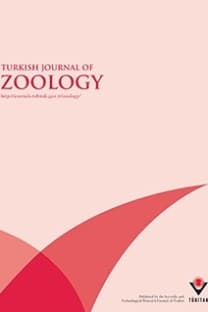Ecology and biology of Allactaga elater, Allactaga euphratica and Allactaga williamsi (Rodentia: Dipodidae) in Turkey
The young of Allactaga williamsi and Allactaga euphratica were born at an average weigth of 2.51 and 2.74 g., respectively. Litter size ranged from 3 to 6 with an average of 4.8 in A. williamsi, and it changed from 4 to 8 with an average of 4.8 in A. euphratica , A. williamsi breeds during the period of March to August, A. williamsi and A. euphratica produced 2 and 2 or 3 litters per year, respectively. Allactaga elater has four types of burrows: winter, summer, reproduction and temporary. A. williamsi and A. euphratica have two types of burrows: reproduction and summer. A. elater was in behavior a more active animal, more eager to explore surrounding habitats than A. euphratica and A. williamsi. Every three species generally feed on plant material, but A. williamsi eats various insects and their larvae in the months April and May. The clear patterns of molting in A. euphratica were observed from July to September; in A. williamsi, molting occured during the period of June to September. Findings revealed that Allactaga species are not agricultural pest.
Ecology and biology of Allactaga elater, Allactaga euphratica and Allactaga williamsi (Rodentia: Dipodidae) in Turkey
The young of Allactaga williamsi and Allactaga euphratica were born at an average weigth of 2.51 and 2.74 g., respectively. Litter size ranged from 3 to 6 with an average of 4.8 in A. williamsi, and it changed from 4 to 8 with an average of 4.8 in A. euphratica , A. williamsi breeds during the period of March to August, A. williamsi and A. euphratica produced 2 and 2 or 3 litters per year, respectively. Allactaga elater has four types of burrows: winter, summer, reproduction and temporary. A. williamsi and A. euphratica have two types of burrows: reproduction and summer. A. elater was in behavior a more active animal, more eager to explore surrounding habitats than A. euphratica and A. williamsi. Every three species generally feed on plant material, but A. williamsi eats various insects and their larvae in the months April and May. The clear patterns of molting in A. euphratica were observed from July to September; in A. williamsi, molting occured during the period of June to September. Findings revealed that Allactaga species are not agricultural pest.
